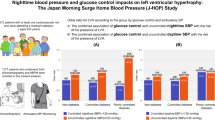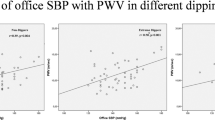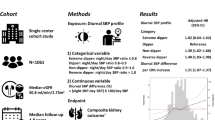Abstract
Patients with longstanding diabetes exhibit diminished nocturnal blood pressure (BP) drop, yet this phenomenon remains understudied in the early stages of the disease. Eighty patients with newly diagnosed (<6 months) Diabetes Mellitus type 2 (T2DM) and 80 non-T2DM individuals underwent office and 24-h ambulatory BP measurements, estimation of hemodynamic parameters using impedance cardiography and blood tests. Ten-year atherosclerotic cardiovascular disease (ASCVD) risk score was calculated. T2DM patients exhibited higher nighttime systolic blood pressure (SBP) (p = 0.028) and lower dipping (p < 0.001) compared to controls. In the total population, dipping correlated negatively with age, HbA1c, ASCVD risk score, and positively with HDL Cholesterol and Velocity Index (VI), a marker of myocardial contractility (p < 0.05). Nighttime SBP correlated positively with ASCVD risk, BMI, HbA1c, fasting glucose, eGFR, and negatively with VI (p < 0.05). After adjustment for other variables, HbA1c (p = 0.03), eGFR (p = 0.02) and VI (p = 0.004) independently predicted non-dipping. Multivariate analysis revealed HbA1c (p = 0.023), eGFR (p = 0.05), and VI (p = 0.006) as independent predictors of nighttime SBP. Patients diagnosed with T2DM concurrently present impaired circadian BP rhythm, which appears to be directly associated with impaired glycemic profile. The observed association with myocardial contractility might represent an additional mechanism for the aggravated cardiovascular risk in these patients.
This is a preview of subscription content, access via your institution
Access options
Subscribe to this journal
Receive 12 digital issues and online access to articles
$119.00 per year
only $9.92 per issue
Buy this article
- Purchase on Springer Link
- Instant access to full article PDF
Prices may be subject to local taxes which are calculated during checkout

Similar content being viewed by others
Data availability
The dataset analyzed during the present study are available from the corresponding author on reasonable request.
References
Nikolaidou B, Gkaliagkousi E, Anyfanti P, Gavriilaki E, Lazaridis A, Triantafyllou A, et al. The impact of hyperglycemia on urinary albumin excretion in recent onset diabetes mellitus type II. BMC Nephrol. 2020;21:119.
Kosiborod M, Gomes MB, Nicolucci A, Pocock S, Rathmann W, Shestakova MV, et al. Vascular complications in patients with type 2 diabetes: prevalence and associated factors in 38 countries (the DISCOVER study program). Cardiovasc Diabetol. 2018;17:150.
American Diabetes A.11. Microvascular complications and foot care: standards of medical care in diabetes-2020. Diabetes Care. 2020;43 Suppl 1:S135–S51.
Ferrannini E, Cushman WC. Diabetes and hypertension: the bad companions. Lancet. 2012;380:601–10.
Nilsson PM, Cederholm J, Zethelius BR, Eliasson BR, Eeg-Olofsson K, Gudbj Rnsdottir S. Trends in blood pressure control in patients with type 2 diabetes: data from the Swedish National Diabetes Register (NDR). Blood Press. 2011;20:348–54.
Cuspidi C, Sala C, Tadic M, Gherbesi E, De Giorgi A, Grassi G, et al. Clinical and prognostic significance of a reverse dipping pattern on ambulatory monitoring: an updated review. J Clin Hypertens. 2017;19:713–21.
Williams B, Mancia G, Spiering W, Agabiti Rosei E, Azizi M, Burnier M, et al. ESC/ESH guidelines for the management of arterial hypertension. Eur Heart J. 2018;39:3021–104. 2018
Kario K. Nocturnal hypertension: new technology and evidence. Hypertension. 2018;71:997–1009.
Fogari R, Zoppi A, Malamani GD, Lazzari P, Destro M, Corradi L. Ambulatory blood pressure monitoring in normotensive and hypertensive type 2 diabetes. Prevalence of impaired diurnal blood pressure patterns. Am J Hypertens. 1993;6:1–7.
Dost A, Klinkert C, Kapellen T, Lemmer A, Naeke A, Grabert M, et al. Arterial hypertension determined by ambulatory blood pressure profiles: contribution to microalbuminuria risk in a multicenter investigation in 2,105 children and adolescents with type 1 diabetes. Diabetes Care. 2008;31:720–5.
Najafi MT, Khaloo P, Alemi H, Jaafarinia A, Blaha MJ, Mirbolouk M, et al. Ambulatory blood pressure monitoring and diabetes complications: Targeting morning blood pressure surge and nocturnal dipping. Medicine. 2018;97:e12185.
Rossen NB, Knudsen ST, Fleischer J, Hvas AM, Ebbehoj E, Poulsen PL, et al. Targeting nocturnal hypertension in type 2 diabetes mellitus. Hypertension. 2014;64:1080–7.
Kario K. Nondipping in nocturnal blood pressure in diabetes: an indicator of autonomic nervous dysfunction? Am J Hypertens. 2007;20:546–7.
Deyneli O, Yazici D, Toprak A, Yuksel M, Aydin H, Tezcan H, et al. Diurnal blood pressure abnormalities are related to endothelial dysfunction in patients with non-complicated type 1 diabetes. Hypertens Res. 2008;31:2065–73.
Felicio JS, de Souza AC, Kohlmann N, Kohlmann O Jr., Ribeiro AB, Zanella MT. Nocturnal blood pressure fall as predictor of diabetic nephropathy in hypertensive patients with type 2 diabetes. Cardiovasc Diabetol. 2010;9:36.
Verdecchia P, Schillaci G, Guerrieri M, Gatteschi C, Benemio G, Boldrini F, et al. Circadian blood pressure changes and left ventricular hypertrophy in essential hypertension. Circulation. 1990;81:528–36.
Nakano S, Uchida K, Kigoshi T, Azukizawa S, Iwasaki R, Kaneko M, et al. Circadian rhythm of blood pressure in normotensive NIDDM subjects. Its relationship to microvascular complications. Diabetes Care. 1991;14:707–11.
Draman MS, Dolan E, van der Poel L, Tun TK, McDermott JH, Sreenan S, et al. The importance of night-time systolic blood pressure in diabetic patients: Dublin Outcome Study. J Hypertens. 2015;33:1373–7.
Tsioufis C, Andrikou I, Thomopoulos C, Syrseloudis D, Stergiou G, Stefanadis C. Increased nighttime blood pressure or nondipping profile for prediction of cardiovascular outcomes. J Hum Hypertens. 2011;25:281–93.
Tsioufis C, Andrikou I, Thomopoulos C, Petras D, Manolis A, Stefanadis C. Comparative prognostic role of nighttime blood pressure and nondipping profile on renal outcomes. Am J Nephrol. 2011;33:277–88.
O’Flynn AM, Dolan E, Curtin RJ, O’Brien E, Perry IJ, Kearney PM. Night-time blood pressure and target organ damage: a comparative analysis of absolute blood pressure and dipping status. J Hypertens. 2015;33:2257–64.
Bouhanick B, Bongard V, Amar J, Bousquel S, Chamontin B. Prognostic value of nocturnal blood pressure and reverse-dipping status on the occurrence of cardiovascular events in hypertensive diabetic patients. Diabetes Metab. 2008;34:560–7.
Boggia J, Li Y, Thijs L, Hansen TW, Kikuya M, Bjorklund-Bodegard K, et al. Prognostic accuracy of day versus night ambulatory blood pressure: a cohort study. Lancet. 2007;370:1219–29.
Lempiäinen PA, Vasunta RL, Bloigu R, Kesäniemi YA, Ukkola OH. Non-dipping blood pressure pattern and new-onset diabetes in a 21-year follow-up. Blood Press. 2019;28:300–8.
Lane-Cordova AD, Kalil GZ, Wagner CJ, Sindler AL, Fiedorowicz JG, Ajibewa T, et al. Hemoglobin A1c and C-reactive protein are independently associated with blunted nocturnal blood pressure dipping in obesity-related prediabetes. Hypertens Res. 2018;41:33–8.
World Health Organization & International Diabetes Federation. Definition and diagnosis of diabetes mellitus and intermediate hyperglycaemia: report of a WHO/IDF consultation. World Health Organization. 2006. Available from: https://apps.who.int/iris/handle/10665/43588.
Use of Glycated Haemoglobin (HbA1c) in the Diagnosis of Diabetes Mellitus: Abbreviated Report of a WHO Consultation. Geneva: World Health Organization; 2011. Available from: https://www.ncbi.nlm.nih.gov/books/NBK304267/.
Mancia G, Fagard R, Narkiewicz K, Redon J, Zanchetti A, Bohm M, et al. ESH/ESC Guidelines for the management of arterial hypertension: the Task Force for the management of arterial hypertension of the European Society of Hypertension (ESH) and of the European Society of Cardiology (ESC). J Hypertens. 2013;31:1281–357.2013
Van De Water JM, Miller TW, Vogel RL, Mount BE, Dalton ML. Impedance cardiography: the next vital sign technology? Chest. 2003;123:2028–33.
Arnett DK, Blumenthal RS, Albert MA, Buroker AB, Goldberger ZD, Hahn EJ, et al. ACC/AHA guideline on the primary prevention of cardiovascular disease: a report of the American College of Cardiology/American Heart Association Task Force on Clinical Practice Guidelines. Circulation. 2019;140:e596–e646. 2019
Aung AT, Chan SP, Kyaing TT, Lee CH. Diabetes mellitus is associated with high sleep-time systolic blood pressure and non-dipping pattern. Postgrad Med. 2020;132:346–51.
Nakano S, Fukuda M, Hotta F, Ito T, Ishii T, Kitazawa M, et al. Reversed circadian blood pressure rhythm is associated with occurrences of both fatal and nonfatal vascular events in NIDDM subjects. Diabetes. 1998;47:1501–6.
Gavriilaki M, Anyfanti P, Nikolaidou B, Lazaridis A, Gavriilaki E, Douma S, et al. Nighttime dipping status and risk of cardiovascular events in patients with untreated hypertension: A systematic review and meta-analysis. J Clin Hypertens (Greenwich). 2020;22:1951–9.
Hermida RC, Crespo JJ, Dominguez-Sardina M, Otero A, Moya A, Rios MT, et al. Bedtime hypertension treatment improves cardiovascular risk reduction: the Hygia Chronotherapy Trial. Eur Heart J. 2020;41:4565–76.
Gkaliagkousi E, Nikolaidou B, Gavriilaki E, Lazaridis A, Yiannaki E, Anyfanti P, et al. Increased erythrocyte- and platelet-derived microvesicles in newly diagnosed type 2 diabetes mellitus. Diabetes Vasc Dis Res. 2019;16:458–65.
Author information
Authors and Affiliations
Contributions
All authors contributed to this study. EG, SD, and BN participated in the design and conception of the study. BN, EG, EIG, PA, ArT, AL, actively participated in subjects’ enrollment. HZ and KM collected and recorded the data. ElG, BN, and PA analyzed and interpreted the data. BN, PA, ElG, and EG edited the final manuscript. SD, AT, and EG corrected and approved the final manuscript. All authors read and approved the final version of the manuscript and agreed to submit it for publication.
Corresponding author
Ethics declarations
Competing interests
The authors declare no competing interests.
Ethical approval
Approval was obtained from the ethics committee of the Aristotle University of Thessaloniki, School of medicine (approval number: 5.44/6/7/16). Written informed consent was obtained from all patients prior to participation in the study.
Additional information
Publisher’s note Springer Nature remains neutral with regard to jurisdictional claims in published maps and institutional affiliations.
Rights and permissions
About this article
Cite this article
Nikolaidou, B., Anyfanti, P., Gavriilaki, E. et al. Non-dipping pattern in early-stage diabetes: association with glycemic profile and hemodynamic parameters. J Hum Hypertens 36, 805–810 (2022). https://doi.org/10.1038/s41371-021-00587-4
Received:
Revised:
Accepted:
Published:
Issue Date:
DOI: https://doi.org/10.1038/s41371-021-00587-4
This article is cited by
-
Clinical Significance of Nocturnal Hypertension and Nighttime Blood Pressure Dipping in Hypertension
Current Hypertension Reports (2023)
-
Association between ambulatory blood pressure monitoring patterns with cognitive function and risk of dementia: a systematic review and meta-analysis
Aging Clinical and Experimental Research (2023)



